Creating a digital product website can feel overwhelming, but breaking it down into manageable steps makes the process achievable, even for beginners. This step-by-step guide will walk you through every stage, from identifying your niche to launching your site and promoting your digital wares. Whether you’re selling ebooks, online courses, software, or digital art, this tutorial will equip you with the knowledge and confidence to build a successful online sales platform.
Quick Summary:
- Define your niche and choose a suitable platform.
- Design your website and set up sales features.
- Create content, promote, and secure your site.
- Continuously analyze performance and improve for growth.
Table of Contents
- 1. Defining Your Niche and Target Audience: Laying the Foundation for Success
- 1.1 Identifying Your Niche
- 1.2 Understanding Your Target Audience
- 1.3 Validating Your Product Idea
- 2. Choosing the Right Platform: Selecting the Foundation for Your Website
- 2.1 Website Builders vs. Content Management Systems (CMS)
- 2.2 Factors to Consider When Choosing a Platform
- 2.3 Recommended Platforms for Selling Digital Products
- 3. Setting Up Your Website: Building Your Online Storefront
- 3.1 Domain Name and Hosting
- 3.2 Installing and Configuring Your Chosen Platform
- 3.3 Choosing a Theme or Template: Design Matters
- 4. Designing Your Website: Creating an Engaging User Experience
- 4.1 Website Structure and Navigation
- 4.2 Visual Design and Branding
- 4.3 Creating Compelling Product Pages
- 5. Setting Up E-commerce Functionality: Enabling Online Sales
- 5.1 Choosing a Payment Gateway
- 5.2 Setting Up a Shopping Cart
- 5.3 Managing Digital Downloads
- 6. Creating High-Quality Content: Attracting and Engaging Your Audience
- 6.1 Blog Posts
- 6.2 Lead Magnets
- 6.3 Email Marketing
- 7. Search Engine Optimization (SEO): Making Your Website Visible
- 7.1 Keyword Research
- 7.2 On-Page Optimization
- 7.3 Off-Page Optimization
- 8. Website Security: Protecting Your Website and Customers
- 8.1 SSL Certificate
- 8.2 Strong Passwords
- 8.3 Regular Backups
- 8.4 Security Plugins (for WordPress)
- 9. Testing and Launching Your Website: Going Live
- 9.1 Testing Your Website
- 9.2 Launching Your Website
- 10. Promoting Your Website: Driving Traffic and Sales
- 10.1 Social Media Marketing
- 10.2 Email Marketing
- 10.3 Content Marketing
- 10.4 Paid Advertising
- 11. Analyzing and Improving: Continuously Optimizing Your Website
- 11.1 Website Analytics
- 11.2 A/B Testing
- 11.3 Customer Feedback
- 12. Scaling Your Digital Product Business: Expanding Your Reach and Revenue
- 12.1 Creating New Products
- 12.2 Expanding Your Marketing Efforts
- 12.3 Outsourcing Tasks
- 13. Qrolic Technologies: Your Partner in Digital Transformation
- 14. Conclusion: Your Journey to Digital Product Success Starts Now
1. Defining Your Niche and Target Audience: Laying the Foundation for Success

Before you even think about design or code, you need to understand who you’re selling to and what problems your digital product solves. This initial research is crucial for tailoring your website’s content and marketing efforts.
1.1 Identifying Your Niche
Your niche is the specific segment of the market you’ll focus on. Choosing a niche that’s both profitable and aligns with your expertise is key.
- Brainstorming: Start by listing your skills, passions, and areas of knowledge. What are you good at? What do you enjoy doing?
- Market Research: Use tools like Google Trends, SEMrush, and Ahrefs to research potential niches. Look for keywords with high search volume and low competition. For example, instead of “online courses,” you might target “online watercolor painting courses for beginners.”
- Competitor Analysis: Identify your competitors and analyze their strengths and weaknesses. What are they doing well? Where can you differentiate yourself?
- Niche Refinement: Narrow down your niche based on your research. Aim for a specific target audience with a clear need for your digital product.
1.2 Understanding Your Target Audience
Once you’ve identified your niche, you need to understand your target audience intimately.
- Creating Buyer Personas: Develop detailed profiles of your ideal customers. Include demographics (age, gender, location), psychographics (interests, values, lifestyle), and their pain points related to your niche. Give them names and stories. Example: “Sarah, a 35-year-old working mother interested in learning photography to capture her children’s milestones.”
- Audience Research: Use surveys, polls, and social media to gather information about your target audience. Ask questions about their needs, challenges, and online behavior.
- Analyzing Feedback: Pay attention to comments, reviews, and forum discussions related to your niche. This can provide valuable insights into what your target audience is looking for.
- Keywords Research for Audience Needs: Utilize keyword research tools to identify the specific language and phrases your target audience uses when searching for solutions to their problems. Integrate these keywords throughout your website content, product descriptions, and marketing materials. This ensures that your website resonates with your target audience and ranks higher in search engine results.
1.3 Validating Your Product Idea
Before investing time and resources into creating your digital product, validate your idea to ensure there’s a demand for it.
- Minimum Viable Product (MVP): Create a basic version of your digital product to test the market. This could be a free ebook, a sample course module, or a beta version of your software.
- Pre-Selling: Offer your digital product for pre-sale to gauge interest and generate revenue. This also allows you to gather feedback and refine your product before launch.
- Surveys and Polls: Conduct surveys and polls to gather feedback on your product idea. Ask potential customers what they would like to see in a digital product related to your niche.
2. Choosing the Right Platform: Selecting the Foundation for Your Website

Selecting the right platform for your digital product website is a critical decision. Several options exist, each with its pros and cons.
2.1 Website Builders vs. Content Management Systems (CMS)
- Website Builders (e.g., Squarespace, Wix, Weebly): These platforms offer drag-and-drop interfaces, making them easy to use for beginners. They typically include hosting, security, and customer support. However, they may have limited customization options and higher long-term costs.
- Content Management Systems (e.g., WordPress, Joomla, Drupal): CMS platforms offer more flexibility and customization options than website builders. WordPress is the most popular CMS, known for its extensive plugin ecosystem and active community. However, they require more technical expertise and may involve additional costs for hosting, themes, and plugins.
2.2 Factors to Consider When Choosing a Platform
- Ease of Use: How comfortable are you with technology? Choose a platform that aligns with your technical skills.
- Customization: Do you need a highly customized website design? CMS platforms offer more customization options than website builders.
- Scalability: Will your business grow over time? Choose a platform that can scale with your needs.
- Cost: Consider the upfront and ongoing costs of each platform. Website builders typically have monthly fees, while CMS platforms may require you to pay for hosting, themes, and plugins.
- E-commerce Functionality: Ensure the platform supports selling digital products. Look for features like shopping carts, payment gateways, and digital download management.
2.3 Recommended Platforms for Selling Digital Products
- WordPress with WooCommerce: WordPress is a powerful CMS, and WooCommerce is a popular e-commerce plugin. This combination offers a high degree of flexibility and customization.
- Shopify: Shopify is a dedicated e-commerce platform that’s easy to use and offers a wide range of features for selling digital products.
- Squarespace: Squarespace is a user-friendly website builder that offers e-commerce functionality, making it a good option for beginners.
- Thinkific/Teachable (Specifically for courses): If your primary product is online courses, these platforms are specifically designed for that purpose, offering features like student management, quizzes, and certificates.
3. Setting Up Your Website: Building Your Online Storefront
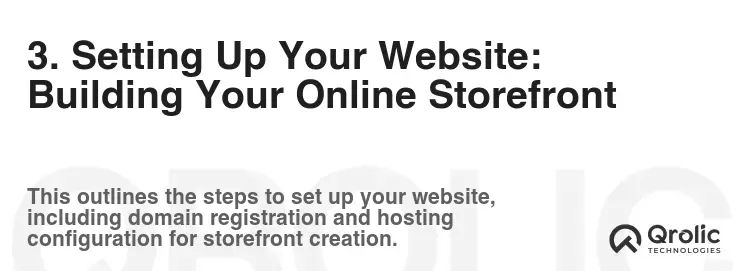
Once you’ve chosen a platform, it’s time to set up your website.
3.1 Domain Name and Hosting
- Choosing a Domain Name: Your domain name is your website’s address. Choose a domain name that’s relevant to your niche, easy to remember, and brandable. Use a domain name registrar like GoDaddy or Namecheap. Aim for a “.com” extension if possible.
- Selecting a Hosting Provider: Hosting is where your website files are stored. Choose a reliable hosting provider with good uptime and customer support. Popular options include Bluehost, SiteGround, and WP Engine (specifically for WordPress). Consider factors like storage space, bandwidth, and server location.
- Connecting Domain and Hosting: Follow your hosting provider’s instructions to connect your domain name to your hosting account. This typically involves updating your domain’s DNS records.
3.2 Installing and Configuring Your Chosen Platform
- Website Builders: Follow the platform’s setup wizard to create your website. Choose a template or theme that aligns with your brand.
- WordPress: Install WordPress through your hosting provider’s control panel or manually by uploading the WordPress files to your server.
- Configuring Your Platform: Customize your platform’s settings, such as your website title, tagline, and permalinks. Install necessary plugins or extensions to enhance functionality.
3.3 Choosing a Theme or Template: Design Matters
- Selecting a Theme: Choose a theme or template that’s visually appealing, mobile-responsive, and optimized for e-commerce.
- Customizing Your Theme: Customize your theme to match your brand identity. Change the colors, fonts, and layout to create a unique look and feel.
- Mobile Responsiveness: Ensure your website is mobile-responsive, meaning it adapts to different screen sizes. This is crucial for providing a good user experience on mobile devices. Use Google’s Mobile-Friendly Test tool to check your website’s responsiveness.
4. Designing Your Website: Creating an Engaging User Experience

Website design is crucial for attracting and retaining customers. A well-designed website is easy to navigate, visually appealing, and optimized for conversions.
4.1 Website Structure and Navigation
- Planning Your Website Structure: Create a sitemap to plan the structure of your website. This will help you organize your content and ensure easy navigation.
- Creating a Clear Navigation Menu: Design a clear and intuitive navigation menu that allows visitors to easily find what they’re looking for. Use concise and descriptive labels for your menu items.
- Implementing Internal Linking: Link to relevant pages within your website to improve SEO and user experience. Internal linking helps search engines understand the structure of your website and allows visitors to easily navigate between related content.
4.2 Visual Design and Branding
- Choosing a Color Palette: Select a color palette that aligns with your brand identity and appeals to your target audience. Use tools like Adobe Color to create harmonious color schemes.
- Selecting Fonts: Choose fonts that are easy to read and visually appealing. Use a combination of a headline font and a body font. Google Fonts offers a wide selection of free fonts.
- Using High-Quality Images and Videos: Use high-quality images and videos to showcase your digital products and engage visitors. Optimize your images for the web to reduce file size and improve page load speed. Use tools like TinyPNG to compress images without losing quality.
4.3 Creating Compelling Product Pages
- Writing Detailed Product Descriptions: Write detailed and persuasive product descriptions that highlight the benefits of your digital products. Use keywords relevant to your niche.
- Showcasing Product Images and Videos: Use high-quality images and videos to showcase your digital products. Show different angles and use cases.
- Adding Customer Reviews and Testimonials: Include customer reviews and testimonials to build trust and credibility. Encourage customers to leave reviews after purchasing your products.
- Crafting a Clear Call to Action (CTA): Use a clear and compelling call to action (CTA) to encourage visitors to purchase your digital products. Examples include “Buy Now,” “Download Now,” or “Get Started Today.” Make your CTAs visually prominent and easy to click.
5. Setting Up E-commerce Functionality: Enabling Online Sales
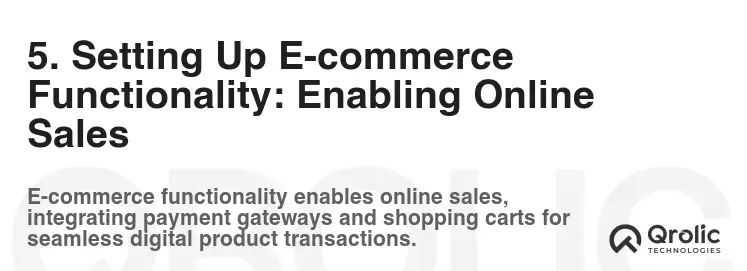
To sell digital products, you need to set up e-commerce functionality on your website. This involves integrating a shopping cart, payment gateway, and digital download management system.
5.1 Choosing a Payment Gateway
- Payment Gateways: Payment gateways process online payments securely. Popular options include PayPal, Stripe, and Authorize.net. Consider factors like transaction fees, security, and ease of integration when choosing a payment gateway.
- Integrating with Your Platform: Follow your platform’s instructions to integrate your chosen payment gateway. This typically involves creating an account with the payment gateway and entering your API keys into your website’s settings.
5.2 Setting Up a Shopping Cart
- Shopping Cart Functionality: Your shopping cart allows customers to add products to their order and proceed to checkout. Ensure your shopping cart is easy to use and mobile-responsive.
- Customizing Your Shopping Cart: Customize your shopping cart to match your brand identity. Change the colors, fonts, and layout to create a seamless shopping experience.
- Offering Different Payment Options: Offer multiple payment options to cater to different customer preferences. This could include credit cards, debit cards, PayPal, and other payment methods.
5.3 Managing Digital Downloads
- Secure Digital Downloads: Protect your digital products by implementing secure digital download management. This prevents unauthorized access and sharing of your products.
- Limiting Download Attempts: Limit the number of download attempts to prevent abuse.
- Adding Watermarks: Add watermarks to your digital products to discourage unauthorized copying.
6. Creating High-Quality Content: Attracting and Engaging Your Audience

Content is king. Creating high-quality content is essential for attracting and engaging your target audience.
6.1 Blog Posts
- Writing Informative and Engaging Blog Posts: Write blog posts that provide valuable information to your target audience. Use keywords relevant to your niche.
- Optimizing Blog Posts for SEO: Optimize your blog posts for search engines by using relevant keywords, writing compelling meta descriptions, and building internal links.
- Promoting Your Blog Posts: Promote your blog posts on social media and other channels to reach a wider audience.
6.2 Lead Magnets
- Creating Valuable Lead Magnets: Create valuable lead magnets, such as free ebooks, checklists, or templates, to attract subscribers to your email list.
- Offering Lead Magnets in Exchange for Email Addresses: Offer your lead magnets in exchange for email addresses. This will help you build your email list and nurture leads.
- Promoting Your Lead Magnets: Promote your lead magnets on your website and social media channels.
6.3 Email Marketing
- Building an Email List: Build an email list to communicate with your audience and promote your digital products.
- Sending Regular Emails: Send regular emails to your subscribers, providing valuable content and promoting your digital products.
- Segmenting Your Email List: Segment your email list based on subscriber interests and behavior. This allows you to send targeted emails that are more likely to convert.
7. Search Engine Optimization (SEO): Making Your Website Visible

SEO is the process of optimizing your website to rank higher in search engine results pages (SERPs). This is crucial for driving organic traffic to your website.
7.1 Keyword Research
- Identifying Relevant Keywords: Identify relevant keywords that your target audience is using to search for information related to your niche. Use keyword research tools like Google Keyword Planner, SEMrush, and Ahrefs.
- Using Keywords Strategically: Use your keywords strategically throughout your website content, including your page titles, meta descriptions, and body text.
7.2 On-Page Optimization
- Optimizing Page Titles and Meta Descriptions: Write compelling page titles and meta descriptions that accurately describe your content and include relevant keywords.
- Using Header Tags (H1-H6): Use header tags (H1-H6) to structure your content and highlight important information.
- Optimizing Images: Optimize your images by using descriptive file names and alt text.
7.3 Off-Page Optimization
- Building High-Quality Backlinks: Build high-quality backlinks from reputable websites in your niche. This can improve your website’s authority and ranking in search results.
- Social Media Promotion: Promote your website on social media to increase its visibility and drive traffic.
- Guest Blogging: Write guest posts for other websites in your niche to build backlinks and reach a wider audience.
8. Website Security: Protecting Your Website and Customers
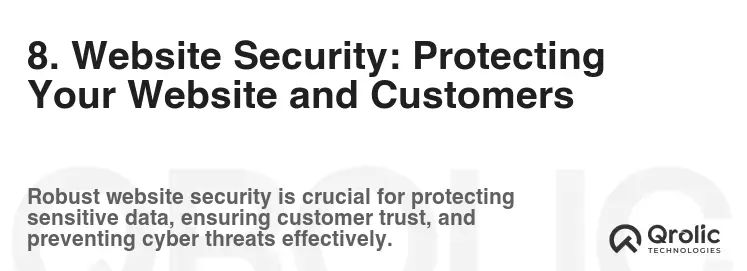
Website security is crucial for protecting your website and customers from cyber threats.
8.1 SSL Certificate
- Installing an SSL Certificate: Install an SSL certificate to encrypt data transmitted between your website and visitors. This will protect sensitive information, such as credit card numbers and passwords. Most hosting providers offer free SSL certificates.
8.2 Strong Passwords
- Using Strong Passwords: Use strong passwords for your website and database. Avoid using easily guessable passwords.
- Two-Factor Authentication: Enable two-factor authentication for your website’s admin panel to add an extra layer of security.
8.3 Regular Backups
- Creating Regular Backups: Create regular backups of your website files and database. This will allow you to restore your website in case of a security breach or other disaster.
- Storing Backups Securely: Store your backups securely in a separate location from your website.
8.4 Security Plugins (for WordPress)
- Installing Security Plugins: Install security plugins to protect your website from malware, brute force attacks, and other threats. Popular security plugins for WordPress include Wordfence and Sucuri Security.
- Keeping Plugins Updated: Keep your plugins updated to patch security vulnerabilities.
9. Testing and Launching Your Website: Going Live

Before launching your website, it’s important to test it thoroughly to ensure everything is working correctly.
9.1 Testing Your Website
- Testing Functionality: Test all of your website’s functionality, including your shopping cart, payment gateway, and digital download management system.
- Checking for Broken Links: Check for broken links on your website and fix them.
- Testing Mobile Responsiveness: Test your website’s mobile responsiveness on different devices and screen sizes.
9.2 Launching Your Website
- Making Your Website Live: Once you’ve tested your website and are satisfied with the results, make it live by updating your DNS records to point to your hosting server.
- Submitting Your Website to Search Engines: Submit your website to search engines like Google and Bing. This will help them crawl and index your website.
- Announcing Your Launch: Announce your website launch on social media and other channels.
10. Promoting Your Website: Driving Traffic and Sales
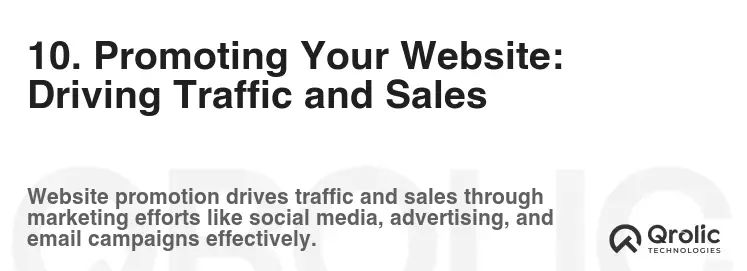
Promoting your website is crucial for driving traffic and sales.
10.1 Social Media Marketing
- Creating a Social Media Strategy: Create a social media strategy that outlines your goals, target audience, and content plan.
- Posting Regularly: Post regularly on social media to engage your audience and promote your digital products.
- Using Social Media Advertising: Use social media advertising to reach a wider audience and drive traffic to your website.
10.2 Email Marketing
- Sending Targeted Emails: Send targeted emails to your subscribers, promoting your digital products and providing valuable content.
- Automating Your Email Marketing: Automate your email marketing to nurture leads and drive sales.
- Tracking Your Email Marketing Results: Track your email marketing results to measure your ROI and optimize your campaigns.
10.3 Content Marketing
- Creating High-Quality Content: Create high-quality content that attracts and engages your target audience.
- Promoting Your Content: Promote your content on social media and other channels to reach a wider audience.
- Guest Blogging: Write guest posts for other websites in your niche to build backlinks and reach a wider audience.
10.4 Paid Advertising
- Using Google Ads: Use Google Ads to target potential customers who are searching for information related to your niche.
- Using Social Media Advertising: Use social media advertising to reach a wider audience and drive traffic to your website.
- Tracking Your Advertising Results: Track your advertising results to measure your ROI and optimize your campaigns.
11. Analyzing and Improving: Continuously Optimizing Your Website
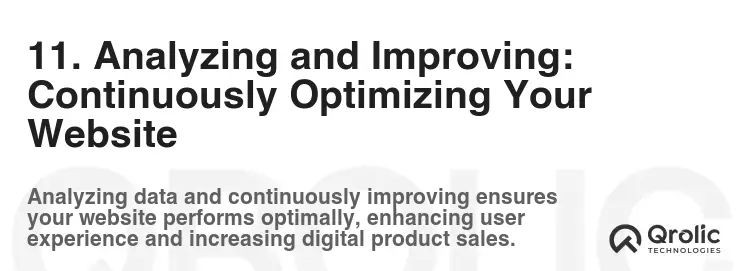
Website optimization is an ongoing process. You should continuously analyze your website’s performance and make improvements to increase traffic, conversions, and sales.
11.1 Website Analytics
- Installing Google Analytics: Install Google Analytics to track your website’s traffic, user behavior, and conversions.
- Analyzing Your Website Data: Analyze your website data to identify areas for improvement.
- Tracking Key Metrics: Track key metrics such as traffic, bounce rate, conversion rate, and sales.
11.2 A/B Testing
- Performing A/B Tests: Perform A/B tests to compare different versions of your website elements and identify which ones perform best.
- Testing Headlines, Images, and CTAs: Test different headlines, images, and CTAs to optimize your website for conversions.
- Analyzing A/B Testing Results: Analyze your A/B testing results to identify which changes have the biggest impact on your website’s performance.
11.3 Customer Feedback
- Gathering Customer Feedback: Gather customer feedback through surveys, polls, and reviews.
- Analyzing Customer Feedback: Analyze customer feedback to identify areas for improvement.
- Responding to Customer Feedback: Respond to customer feedback promptly and professionally.
12. Scaling Your Digital Product Business: Expanding Your Reach and Revenue

Once you’ve established a successful digital product website, you can start scaling your business to expand your reach and revenue.
12.1 Creating New Products
- Identifying New Product Opportunities: Identify new product opportunities by analyzing customer feedback, conducting market research, and monitoring industry trends.
- Developing New Digital Products: Develop new digital products that meet the needs of your target audience.
- Launching New Products Strategically: Launch new products strategically to maximize their impact.
12.2 Expanding Your Marketing Efforts
- Exploring New Marketing Channels: Explore new marketing channels to reach a wider audience.
- Increasing Your Marketing Budget: Increase your marketing budget to drive more traffic and sales.
- Partnering with Other Businesses: Partner with other businesses in your niche to cross-promote your products.
12.3 Outsourcing Tasks
- Identifying Tasks to Outsource: Identify tasks that can be outsourced to free up your time and focus on core business activities.
- Hiring Freelancers or Agencies: Hire freelancers or agencies to handle tasks such as website design, content creation, and marketing.
- Managing Outsourced Tasks Effectively: Manage outsourced tasks effectively to ensure they are completed on time and to your satisfaction.
13. Qrolic Technologies: Your Partner in Digital Transformation
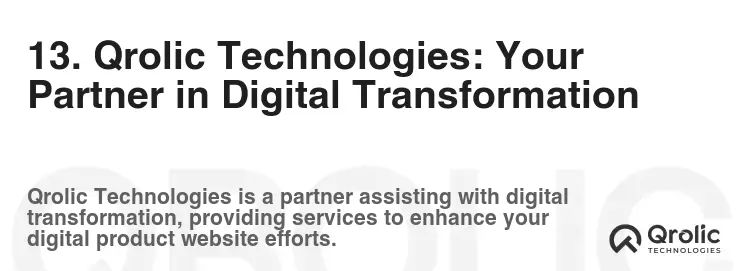
At Qrolic Technologies (https://qrolic.com/), we empower businesses to thrive in the digital age. We offer a comprehensive suite of services, including:
- Website Design and Development: We create visually stunning and user-friendly websites that drive conversions.
- E-commerce Solutions: We build robust and scalable e-commerce platforms that enable you to sell your products online with ease.
- SEO and Digital Marketing: We help you rank higher in search engine results and reach a wider audience through our SEO and digital marketing services.
- Custom Software Development: We develop custom software solutions that meet your specific business needs.
Whether you’re just starting out or looking to scale your existing digital product business, Qrolic Technologies can help you achieve your goals. Contact us today to learn more about our services. We can help with your online sales design, and creating the perfect digital product website by following a step-by-step guide from us.
14. Conclusion: Your Journey to Digital Product Success Starts Now
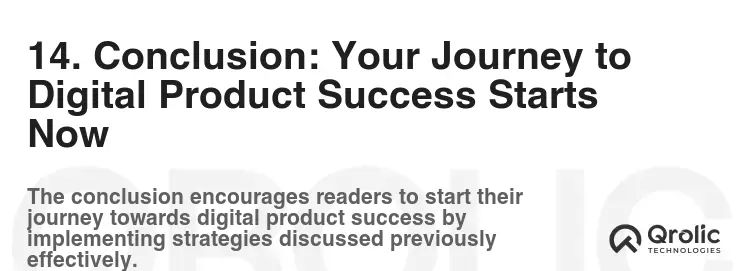
Creating a successful digital product website requires careful planning, execution, and continuous optimization. By following the steps outlined in this guide, you can build a website that attracts customers, generates sales, and helps you achieve your business goals. Remember to focus on providing value to your target audience, creating high-quality content, and continuously analyzing and improving your website. Your journey to digital product success starts now. Embrace the challenge, learn from your mistakes, and never stop innovating. The digital world is constantly evolving, and staying ahead of the curve is essential for long-term success.






